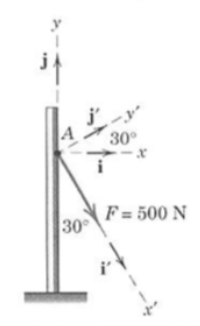
College Physics
11th Edition
ISBN: 9781305952300
Author: Raymond A. Serway, Chris Vuille
Publisher: Cengage Learning
expand_more
expand_more
format_list_bulleted
Concept explainers
Question
thumb_up100%
A 500 N F force is applied to the vertical rod, as shown in picture below. Write F as a function of the unit vectors i and j, and identify their vector and scalar components.

Transcribed Image Text:A
30°
F = 500 N
30
Expert Solution
This question has been solved!
Explore an expertly crafted, step-by-step solution for a thorough understanding of key concepts.
This is a popular solution
Trending nowThis is a popular solution!
Step by stepSolved in 2 steps with 2 images

Knowledge Booster
Learn more about
Need a deep-dive on the concept behind this application? Look no further. Learn more about this topic, physics and related others by exploring similar questions and additional content below.Similar questions
- The grid runs from -5 to 5 on both axes. Drawn on this grid are four vectors, labeled A⃗ A→ through D⃗ D→. This problem will ask you various questions about these vectors. All answers should be in decimal notation, unless otherwise specified. A. What is the xcomponent of A→? B.What is the y component of A⃗ ? C.What is the y component of B⃗ ? D.What is the x component of C⃗ ? E. In ordered pair notation, write down the components of vector B⃗ F. In ordered pair notation, write down the components of vector D G.What is true about B⃗ and D⃗ ? They have different components and are not the same vectors. They have the same components but are not the same vectors. They are the same vectors.arrow_forwardHow would I figure out the adding and subtracting parallel vectors? how would I figure out the adding and subtracting anti-parallel vectors?arrow_forwardPLEASE ANSWER THE FOLLOWING USING KEYBOARD (TEXT NOT HAND WRITING) Given a certain vector of arbitrary length, why is it useful to compute the unit vector of this vector?arrow_forward
- Our vectors P and Q have the same amount. How can we rearrange them so that the sum of them is toward the right? Explain this?arrow_forwardGiven M = 6 î + 5 j – 6 k and N = 3 î - 3 j - 3 k, calculate the vector product M x N. j +arrow_forwardFigure a H tā V Rank the vector combinations on the basis their angle, measured counterclockwise from the positive z axis. Vectors parallel to the positive z axis have an angle of 0°. All angle measures fall between 0 and 360° Rank from largest to smallest. To rank items as equivalent, overlap them. View Available Hint(s) largest The correct ranking cannot be determined. a+b á+é á+da+ef+ë d Reset smallarrow_forward
- Use the definition of scalar product, a = ab cos 0, and the fact that a . the two vectors given by a = 3.01 +3.0 + 3.0k and b Number i Units = axbx + ab + a₂b₂ to calculate the angle between 4.0î + 9.0ĵ + 7.0k. =arrow_forwardFind a unit vector perpendicular to A = (î+ ĵ – Îk) and B = ( 2i + j- 3k). (Hints. One method to find the unit vector C perpendicular to A and B will be to use the fact that the cross product is perpendicular to both vectors A and B, but keep in mind that the magnitude of the unit vector is one. There is another method which is a little bit longer by using the fact that the dot product AC=0 and BC=0 where C is the unit vector )arrow_forwardFor the vectors shown in the figure, find the magnitude and direction of the vector product A C. B' 6. 70° 40° 8. 48, directed out of the page 45. directed out of the page O 16. directed out of the page O 48, directed into the page O 45, directed into the page ) 16, directed into the pagearrow_forward
- What is the relation between A×B and BxA, The magnitudes are the same but they are in opposite directions, i.e., (Ã×B)=-(BxÃ) The order of the vectors in a cross product doesn't matter so they are the same, i.e., (ÃxB)=(BxÃ)arrow_forwardFor the vectors in the figure, with a = 8.0, b = 6.0, and c = 10 what are the magnitude and the direction b×c?arrow_forwardhleparrow_forward
arrow_back_ios
SEE MORE QUESTIONS
arrow_forward_ios
Recommended textbooks for you
 College PhysicsPhysicsISBN:9781305952300Author:Raymond A. Serway, Chris VuillePublisher:Cengage Learning
College PhysicsPhysicsISBN:9781305952300Author:Raymond A. Serway, Chris VuillePublisher:Cengage Learning University Physics (14th Edition)PhysicsISBN:9780133969290Author:Hugh D. Young, Roger A. FreedmanPublisher:PEARSON
University Physics (14th Edition)PhysicsISBN:9780133969290Author:Hugh D. Young, Roger A. FreedmanPublisher:PEARSON Introduction To Quantum MechanicsPhysicsISBN:9781107189638Author:Griffiths, David J., Schroeter, Darrell F.Publisher:Cambridge University Press
Introduction To Quantum MechanicsPhysicsISBN:9781107189638Author:Griffiths, David J., Schroeter, Darrell F.Publisher:Cambridge University Press Physics for Scientists and EngineersPhysicsISBN:9781337553278Author:Raymond A. Serway, John W. JewettPublisher:Cengage Learning
Physics for Scientists and EngineersPhysicsISBN:9781337553278Author:Raymond A. Serway, John W. JewettPublisher:Cengage Learning Lecture- Tutorials for Introductory AstronomyPhysicsISBN:9780321820464Author:Edward E. Prather, Tim P. Slater, Jeff P. Adams, Gina BrissendenPublisher:Addison-Wesley
Lecture- Tutorials for Introductory AstronomyPhysicsISBN:9780321820464Author:Edward E. Prather, Tim P. Slater, Jeff P. Adams, Gina BrissendenPublisher:Addison-Wesley College Physics: A Strategic Approach (4th Editio...PhysicsISBN:9780134609034Author:Randall D. Knight (Professor Emeritus), Brian Jones, Stuart FieldPublisher:PEARSON
College Physics: A Strategic Approach (4th Editio...PhysicsISBN:9780134609034Author:Randall D. Knight (Professor Emeritus), Brian Jones, Stuart FieldPublisher:PEARSON

College Physics
Physics
ISBN:9781305952300
Author:Raymond A. Serway, Chris Vuille
Publisher:Cengage Learning

University Physics (14th Edition)
Physics
ISBN:9780133969290
Author:Hugh D. Young, Roger A. Freedman
Publisher:PEARSON

Introduction To Quantum Mechanics
Physics
ISBN:9781107189638
Author:Griffiths, David J., Schroeter, Darrell F.
Publisher:Cambridge University Press

Physics for Scientists and Engineers
Physics
ISBN:9781337553278
Author:Raymond A. Serway, John W. Jewett
Publisher:Cengage Learning

Lecture- Tutorials for Introductory Astronomy
Physics
ISBN:9780321820464
Author:Edward E. Prather, Tim P. Slater, Jeff P. Adams, Gina Brissenden
Publisher:Addison-Wesley

College Physics: A Strategic Approach (4th Editio...
Physics
ISBN:9780134609034
Author:Randall D. Knight (Professor Emeritus), Brian Jones, Stuart Field
Publisher:PEARSON